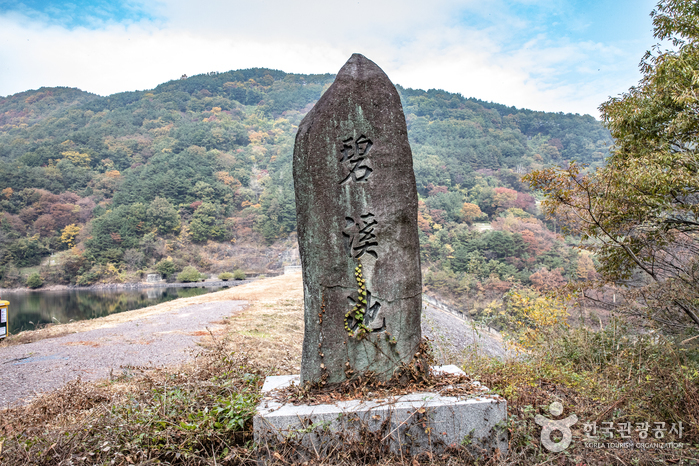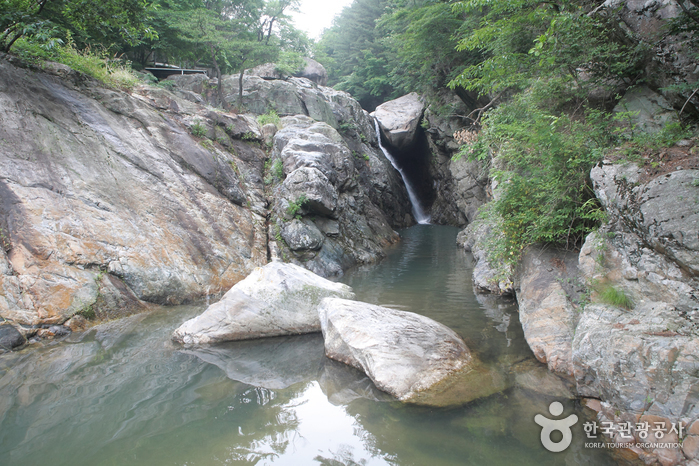Byeokgyegyegok (Chalbi) Valley (벽계(찰비)계곡)
15.3 Km 14318 2021-02-20
201, Byeokgye-ro, Uiryeong-gun, Gyeongsangnam-do
+82-55-570-4958
Byeokgyegyegok Valley in Uiryeong, Gyeongnam region begins at Jagulsan Mountain and runs down along Hanusan Mountain, showcasing deep valleys and interesting rock formations. Also called Chalbigyegok Valley, the valley has clean water flowing all year round. The valley’s stream from the waterfall creates big and small ponds along its way, most famous among which are Gaksiso and Nongso ponds.
The biggest draw of this attraction is the crystal clear pond waters that are clean enough to reflect the surrounding forest like a natural mirror. Byeokgye Tourist Site and Byeokgye Reservoir located near the tail-end of the valley are growing into full-fledged tourist attractions for camping and fishing.
Sancheongyulsuwon [Korea Quality] / 산청율수원 [한국관광 품질인증]
15.6 Km 13079 2020-09-10
36, Sindeunggahoe-ro Sindeung-myeon, Sancheong-gun, Gyeongsangnam-do
+82-55-974-0221, +82-10-9802-1132
Sancheong Yulsuwon was opened in October 2013 as traditional hanok accommodations to provide guests comfort and relaxation in nature. It was named after the expression from “Decade of Wen Wang” of the Classics of Poetry (the oldest existing collection of Chinese poetry), meaning “Following the virtue of ancestors, one should cultivate one’s mind,” in the hope that guests can experience traditional Korean culture in hanok and learn common themes and cultivate virtues in life. Located at the hanok street in Sancheong County, Gyeongsangnam-do Province, Sancheong Yulsuwon is a hanok stay facility established by Korea’s major education company JEI Corporation. It was built by expanding and renovating the Old House of Suncheon Park’s Clan for over four years. It is not only a hanok cultural facility but also an educational facility that aims to provide visitors comfortable relaxation and to establish a sound, rich environment of educational culture, which is also the philosophy of JEI Corporation. It is located around the Dumulmeori area where Dangyecheon Stream and Sindeungcheon Stream -- the water branch of Hwangmaesan Mountain (1,108m above sea level) -- meet. The area is known for many houses of noble families situated in a propitious site combined with mountains and water and as a hanok village with the old stone wall, which was designated as a cultural heritage. Among them, Sancheong Yulsuwon is an outstanding hanok structure built on a total area of about 2,975m2 according to the theory of divination based on topography.
Entering the main gate Yeongsumun, one sees the Anchae (inner house) situated in front, the outer Sarangchae (detached building) on the right, and the bathroom on the left. Then, there are the inner Sarangchae, the kitchen, and the pavilion around the vegetable garden and the pond. The arrangement of buildings has special meaning: the kitchen signifies a green dragon (east), the bathroom, a white tiger (west), the inner Sarangchae, an Ansan (a low and small mountain in front of the house), and the outer Sarangchae and the main gate, a Josan (a high mountain behind Ansan); these five buildings seem to embrace the Anchae. As for the special names of the buildings, the inner Sarangchae built with the splendid style of semi-hipped roof and double eaves was named “Nongam,” meaning “a thatched cottage of a skilled farmer”; the outer Sarangchae was named “Goheon,” meaning “an old sarangchae,” and the Anchae -- named “Hagyejae” meaning “modesty” -- is situated in the innermost area. In particular, its upper floor (numaru) offers an open view of the environment. The bathroom, which was named “Seoljodang” meaning “one should keep the mind and body clean,” is composed of two connected houses. It is also equipped with red clay sauna and jjimjilbang (Korean dry sauna).
Sancheong Yulsuwon was built based on a traditional hanok style of the Yeongnam area, with a splendid Seoul style of modernity added to the design. The sunshine comes through the windows made of hanji (Korean paper) in the clean and cozy rooms. Guests can also enjoy the outside view from the windows, which show the typical scenery of hanok consisting of jars, trees, flowers, and low stone wall with tiled roof. Every room is equipped with a bathroom including a bathtub and a modern-style kitchen. Sancheong Yulsuwon is adjacent to various tourist attractions including the following: valley of Daewonsa Temple surrounded by Geumgang pine trees; Namsa Yedamchon village, a village with an old wall made of red clay and stones; and Jeongchiwam Hermitage, Traditional Buddhist Temple No. 83 built by Silla’s Buddhist monk Uisang (625-702) and where the Buddhist Painting of Mountain Spirit can be found.
Odosan Recreational Forest (오도산자연휴양림)
15.8 Km 37162 2014-08-05
398, Odosanhyuyang-ro, Bongsan-myeon, Hapcheon-gun, Gyeongsangnam-do
+82-55-930-3733
Odosan Recreational Forest is to the north of Haeinsa Temple, one of the three most important temples in Korea, and to the south of Hapcheonho Lake. The Forest’s convenience facilities include 18 Forest Cabins divided into 2 areas, a Youth Training Center that can accommodate 30 people, and 28 water playing sites. In addition, 63 camping decks are available.
Jeongchwiam Hermitage (정취암)
16.2 Km 26272 2024-02-23
675-87 Duncheolsan-ro, Sindeung-myeon, Sancheong-gun, Gyeongsangnam-do
Jeongchwiam Hermitage is a temple perched on the rocky cliffs of Daeseongsan Mountain, celebrated as a prime location for witnessing both sunrise and sunset, each offering breathtaking views. Nestled amidst picturesque mountain landscapes, the temple is cherished by many for its serene surroundings. Nearby attractions include the Duncheol Ecological Park and Seonyudonggyegok Valley, both serving as captivating natural destinations for tourists.
Gamaksan Wind Farm (감악산 풍력발전단지)
16.5 Km 1 2024-02-23
San 57 Deoksan-ri, Sinwon-myeon, Geochang-gun, Gyeongsangnam-do
Gamaksan Wind Farm is a wind power complex located near the summit of Gamaksan Mountain in Geochang. The site, once a barren land, has been transformed into a flower garden with the planting of flowers such as Mother Chrysanthemum, Aster, Siberian Chrysanthemum, and Sliver Grass. It offers a panoramic view of Geochang-eup and Hapcheonho Lake. There are photo zones scattered throughout, providing excellent opportunities for photography. One of the main events is the Flower & Star Festival held in October. Visitors can enjoy vibrant purple asters and participate in programs like forest ecology experience and aromatherapy.
Ilbungsa Temple (일붕사(의령))
17.1 Km 26801 2024-02-28
1180-42 Cheongjeong-ro, Gungnyu-myeon, Uiryeong-gun, Gyeongsangnam-do
Situated at the base of Bonghwangsan Mountain in Uiryeong, Ilbungsa Temple is renowned for being the world's largest cave temple, a distinction recognized by the Guinness World Records. It features two cave temples, including the Daeungjeon Hall Grotto and Muryangsujeon Grotto. A sought-after destination for those seeking the fulfillment of their wishes through prayer, Ilbungsa Temple is surrounded by other attractions including the Byeokgye Tourist Complex, Chalbigyegok Valley, and Bonghwangdae Cliff.
Seonyudonggyegok Valley (Sancheong Section) (선유동계곡(산청))
19.0 Km 9348 2022-08-10
Suwol-ro, Sancheon-gun, Gyeongsangnam-do
+82-55-970-7205
Seonyudong means the place where fairies come down from heaven to play. It has been said that fairies would often come down to the valley to make liquor and store them in flagons. There are some leftover depressions in the boulders which demonstrate there may be some truth to the legend.
Near Seonyudonggyegok Valley, they say that the bamboos and pine trees stay green all year long and wood nymphs fly down to play with each other under the Suwolpokpo Falls in Suwol Village.

![Sancheongyulsuwon [Korea Quality] / 산청율수원 [한국관광 품질인증]](http://tong.visitkorea.or.kr/cms/resource/07/2631407_image2_1.jpg)


 English
English
 한국어
한국어 日本語
日本語 中文(简体)
中文(简体) Deutsch
Deutsch Français
Français Español
Español Русский
Русский